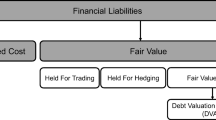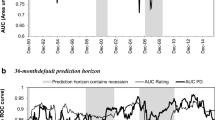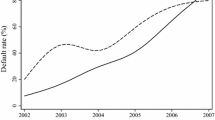Abstract
We examine two interrelated issues in risk-adjusted return on capital performance measurement: estimating hurdle rates and allocating capital to debt instruments in a portfolio. We consider a methodology to differentiate hurdle rates for individual debt instruments that incorporates obligor-specific information. These instrument-specific hurdle rates, which define the required compensation of the shareholders, enable a granular differentiation of systematic risk among debt contracts. Using the proposed approach, we show that the hurdle rate could be materially different among industry sectors and obligors of different credit quality. Profitability assessment could be significantly distorted if the difference in hurdle rates is ignored.


Similar content being viewed by others
Notes
The marginal hurdle rate examined in the existing literature (e.g., Stoughton and Zechner 2007) does not capture the marginal cost of equity based on the systematic risk of individual debt instruments.
In this section, although we describe the implementation of the RAROC framework on loan portfolios, the discussion and related methodologies are equally applicable to any credit portfolio that is held by a financial institution in general.
Drzik et al. (1998) show that economic capital is a tail risk measure representing the shareholders’ equity as the first loss-absorbing tranche protecting the FI’s debtholders. This framework can be readily extended to incorporate the notion of protecting the values of policy holders in the setting of an insurance company.
However, a recent survey conducted by Mehta et al. (2012) suggests that the choice of confidence level (as defined by \( {\delta}_1 \) and \( {\delta}_2 \)) is becoming less related to risk appetite and target rating subsequent to the recent financial crisis.
For example, in Moody’s KMV RiskFrontier®, which uses the proprietary GCorr® factor model, individual instruments are assigned sector and geographic classifications which together with the instrument’s R-squared value are then used to generate correlated asset returns in the simulation of the 1-year distribution of portfolio loss. The resulting weighting of the instrument’s underlying asset return on the global factor within GCorr® implies a covariance between asset returns and market returns, which can be used to calculate the beta of the instrument’s underlying asset.
Quite a number of the obligors in our portfolio have relatively low credit rating (e.g., B or below). Although it is quite unlikely that a typical FI will enter into a loan agreement with an obligor of such a low credit rating, we may indeed find lowly-rated obligors in existing credit portfolio of an FI as the financial health of some of the originally credit-worthy obligors has deteriorated due to firm-specific and/or market-wide conditions.
Note that the GCorr model is a multifactor model. As a result, one may argue that the asset beta derived from the GCorr model may not be the same as the asset beta of the CAPM model. For those publicly-traded obligors with valid market information, rather than using the GCorr model, one may conduct her own estimations of beta and standard deviation of asset return of each obligor by adopting a market model.
In evaluating Eq. (26), we further assume the cost of debt of the FI (\( {k}^B \)) equals to the risk-free interest rate of 2 %. Although short-term funding for an FI is likely to be much more expensive than the risk-free interest rate, the weighted average cost of debt of deposit-taking FIs could be lower and not very different from the risk-free rate given the substantial size of their low-cost deposit bases.
As discussed earlier in the paper, the observed market CDS spreads account for more than just the credit risk of the debt instruments, as they may contain a significant liquidity premium. Therefore, the expected income implied by the CDS spread is likely to be higher than the true expected income that is solely based on the credit risk of the obligor. As a result, we will tend to overstate the number of instruments having RAROCs that exceed their respective hurdle rates. When implementing the proposed methodology in practice, a financial institution should have all the actual income information of each instrument in its credit portfolio to calculate the RAROC measures.
An important limitation of RAROC analysis is highlighted in the comparison of the relative performance of instruments. That is, the RAROC of any individual instrument is dependent on the legacy portfolio to which it has been added. For example, a new loan underwritten to an information technology company will attract a higher capital requirement if the existing loan portfolio already has a high concentration on information technology obligors than if the existing portfolio is in fact well diversified. Thus, the RAROC of a new loan and, in turn, whether it will create value for the shareholders of the FI are dictated by the composition of the existing portfolio. Moreover, as removing loans from a portfolio affects the capital requirements of the remaining loans, the results of portfolio management on a RAROC basis can vary depending on the order in which underperforming loans are removed. This is a noteworthy shortcoming of RAROC metrics that deserves further study and investigation. In the present study, we focus on how we may improve the RAROC analysis by introducing differentiated and instrument-specific hurdle rates.
References
Acerbi C, Tasche D (2002) Expected shortfall: a natural coherent alternative to value at risk. Econ Notes 31(2):379–388
Artzner P, Delbaen F, Eber J-M, Heath D (1999) Coherent measures of risk. Math Financ 9(3):203–228
Baer T, Mehta A, Samandari H (2011) The use of economic capital in performance management for banks: a perspective. McKinsey & Company
Crouhy M, Turnbull SM, Wakeman LM (1999) Measuring risk-adjusted performance. J Risk 2(1):5–35
Damodaran A (2012) Equity Risk Premiums (ERP): Determinants, Estimation and Implications – the 2012 edn. Working paper, Stern School of Business, http://papers.ssrn.com/sol3/papers.cfm?abstract_id=2027211
Dhaene J, Tsanakas A, Valdez E, Vanduffel S (2009) Optimal capital allocation principles. The 9th International Congress on Insurance: Mathematics and Economics (MIE2005)
Drzik J, Nakada P, Schuermann T (1998) The debtholder’s perspective: risk, capital, and value measurement in financial institutions - part I. J Lend Credit Risk Manag
Froot KA, Stein JC (1998) Risk management, capital budgeting, and capital structure policy for financial institutions: an integrated approach. J Financ Econ 47:55–82
Jackson P, Perraudin W, Sapporta V (2002) Regulatory and “economic” solvency standards for internationally active banks. J Bank Financ 26:953–976
James C (1996) RAROC based capital budgeting and performance evaluation: a case study of bank capital allocation. The Wharton Financial Institutions Center working paper 96–40
James C, Kizilaslan A (2014) Asset specificity, industry driven recovery risk and loan pricing. J Financ Quant Anal 49(3): 599–631
Kalkbrener M (2005) An axiomatic approach to capital allocation. Math Financ 15:425–437
Kalkbrener M, Lotter H, Overbeck L (2004) Sensible and efficient capital allocation for credit portfolios. Risk S19–S24
Keisman D, Marshella T (2009) Recoveries on Defaulted debt in an Era of black swans. Moody’s Global Corporate Finance, Moody’s Investments Service
Kimball RC (1998) Economic profit and performance measurement in banking. New Engl Econ Rev 35–53
Levy A (2008) An overview of modeling credit portfolios. Moody’s KMV Company
Mehta A, Neukirchen M, Pfetsch S, Poppensieker T (2012) Managing market risk: today and tomorrow. McKinsey Working Papers on Risk, Number 32, McKinsey & Company
Merton RC (1974) On the pricing of corporate debt: the risk structure of interest rates. J Financ 29:449–470
Milne A, Onorato M (2012) Risk-adjusted measures of value creation in financial institutions. Eur Financ Manag 18(4):578–601
Moody’s KMV Company (2007) Why Choose RiskFrontierTM?
Rosen D, Saunders D (2010) Risk factor contributions in portfolio credit risk models. J Bank Financ 34:336–349
Stoughton NM, Zechner J (2007) Optimal capital allocation using RAROC and EVA. J Financ Intermed 16:312–342
Tasche D (2008) Capital allocation to business units and Sub-portfolios: the Euler principle. In: Resti A (ed) Pillar II in the new Basel accord: the challenge of economic capital. Risk Books, London, pp 423–453
Vasicek O (1987) Probability of loss on loan portfolio. KMV Corporation
Wilson T (2003) Overcoming the hurdle. Risk 79–83
Zaik E, Walter J, Kelling G, James C (1996) RAROC at Bank of America: from theory to practice. J Appl Corp Financ 9(2):83–93
Author information
Authors and Affiliations
Corresponding author
Appendix A: Additional statistics of the sample portfolio
Appendix A: Additional statistics of the sample portfolio
Rights and permissions
About this article
Cite this article
Miu, P., Ozdemir, B., Cubukgil, E. et al. Determining Hurdle Rate and Capital Allocation in Credit Portfolio Management. J Financ Serv Res 50, 243–273 (2016). https://doi.org/10.1007/s10693-015-0221-2
Received:
Revised:
Accepted:
Published:
Issue Date:
DOI: https://doi.org/10.1007/s10693-015-0221-2




